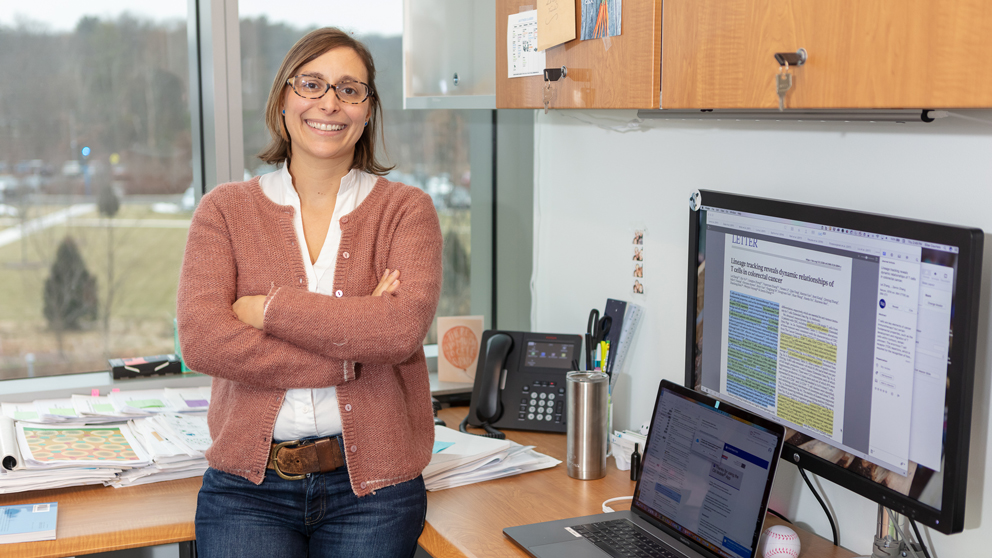
Research Scientist Elise Courtois, Ph.D., in her office at The Jackson Laboratory for Genomic Medicine in Connecticut. JAX photo by Charles Camarda.
A close friendship sparked interest in Elise Courtois, Ph.D., to explore this common gynecological disease.
Imagine spending years in chronic, debilitating pain with no definite diagnosis. Upon learning that it’s endometriosis, if you chose to seek treatment, you face losing your reproductive organs and the option to be a parent.
Pain, infertility, and ignorance: this is the reality for endometriosis patients.
Elise Courtois, Ph.D., is a research scientist in the Paul Robson, Ph.D.Areas of expertise include single cell transcriptomics, primate/human early embryonic development, maternal-fetal medicine, fetal programming, pluripotent cell biology, regulatory networks, tumor heterogeneity, circulating tumor cells.Robson Lab at The Jackson Laboratory for Genomic Medicine in Farmington, Conn. She recently launched a research project to study the genetics of endometriosis, and The Department of Defense awarded a $378,000 Discovery Award to Courtois for this work, which will help develop foundational knowledge about endometriosis. She hopes to help afflicted endometriosis patients, like her close friend Patricia Muñoz Jimenez.
“Endometriosis took my smile away for many years. It was a long and hard journey to get to where I finally am,” Muñoz Jimenez says. Her case is only one instance of the 1 in 10 people with uteruses who are afflicted by endometriosis during their reproductive years. “I am pleased that [Courtois] will conduct her research on a disease that is still misunderstood by so many, by society, and even by some clinicians.”
Endometriosis arises when tissue that usually lines the inside of the uterus — the endometrium — grows outside of the womb, creating complex ectopic lesions. The endometrium-like lesions are painful and can severely affect the quality of life.
Little research has been done on this disease; thus, there are no non-surgical diagnostics, treatments, or cures. It usually takes five to ten years for a patient to receive ‘surgical’ diagnosis, at which point the disease is already advanced. Surgical removal of lesions can provide relief, but lesions usually recur. Hysterectomy, removal of the uterus, provides more permanent relief, but leads to infertility and is not ideal for the majority of afflicted reproductive-aged patients.
“There is an urgent need for answers in this field,” says Courtois. She plans to use an unbiased single cell approach to analyze endometrial lesions and its evolving ecosystem. She hopes to understand how endometriosis establishes, progresses, and spreads, and ultimately find new biomarkers for better diagnostics and therapeutics.
“We have strong clinical collaborators and cutting-edge technologies, so I’m really hoping this moves forward into a full-blown line of endometriosis research,” Courtois says. The end goal is to find tools for diagnosis and treatment that will provide early solutions to a common gynecological disease.